Bottomless Precedent: BP Gulf Gusher Endemic to Global Oil Problem
Big spills from the Ecuadorian Amazon to the Niger Delta, all the way to the bitter cold of Russia’s Siberian tundra.
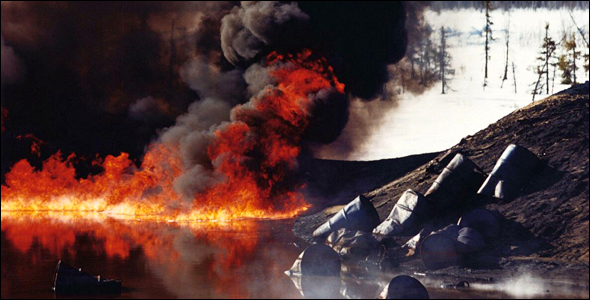
By Aubrey Ann Parker
Circle of Blue
Day 63. The unending torrent into the Gulf of Mexico–measuring 125 million gallons and growing–is the latest evidence that the planet’s devotion to oil is producing a new era of colossal environmental and economic damage. The deepwater blowout is fouling marshes and beaches in four states and laying waste to fisheries that employ thousands. The disaster also is confounding the U.S. government’s technical capacity to plug the leak, and setting new measures for calculating and collecting monetary damages.
Most importantly for the global environment, though, is that the BP PLC spill is just one of a growing number of environmental oil-related calamities that are scarring the earth, polluting the water, and threatening the lives and livelihoods of millions of people. Almost every continent is affected:
War on Water: Oil, Power and Poverty in the Niger Delta
After almost one year of a relative ceasefire, a clash between an aggressive guerrilla militia and the military has resumed this month in the Niger Delta over control of Nigeria’s oil revenues, thought to be hoarded by the wealthy and the southern region’s government.
Royal Shell Co., the Nigerian National Petroleum Corporation and Chevron all have stakes in the region’s lucrative resource, which as recently as 2008 produced 2.1 million barrels per day.
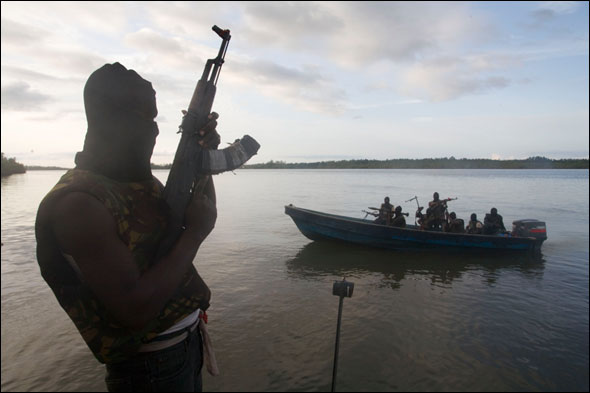
Rebels are blowing up pipelines, destroying equipment and ransoming oil workers as a way of protesting the corruption. The attacks have unleashed a new torrent of leaking oil, adding to the accumulation of oil-related environmental damage over the years. The series of canals and tributaries that cross the Niger Delta have been completely devastated by petroleum pollution since oil was discovered in 1956.
The Nigerian Federal Ministry of the Environment says that anywhere from 9 million to 13 million barrels (380-550 million gallons) have spilled each year during the history of oil production in the Niger Delta—the equivalent in size of the U.S. Exxon Valdez spill in 1989, but occurring annually for the last five decades. Meanwhile the United Nations estimates that nearly 7000 spills occurred between 1976 and 2001–half of which were due to corrosion of pipelines and storage tanks, while 28 percent were caused by sabotage.
Tens of thousands of residents were forced to evacuate the region last year, left to wade through the world’s third largest wetland in search of safer homes. Their lives are endangered not only by the fighting, but also by the toxins, industrial wastes and oil-slicks that are poisoning their drinking water as well as contaminating their fish.
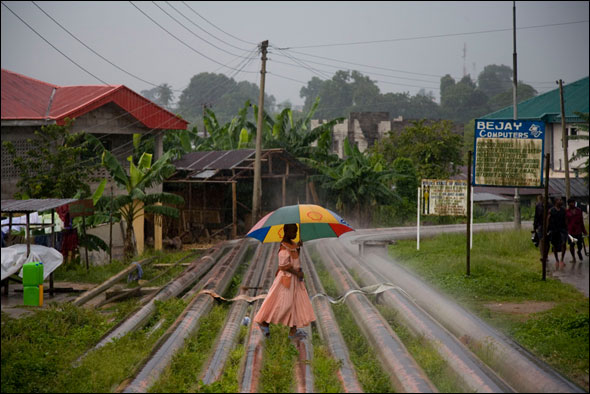
“There are no heroes in this fight,” Ed Kashi, photographer of Curse of the Black Gold: 50 years of Oil in the Niger Delta, told Circle of Blue in May 2009. “It is the equivalent of gang warfare over turf and control, and instead of crack cocaine it’s oil, and instead of being on the main streets of a city, it’s out on rivers and creeks on small boats.”
Water Pollution in Ecuador’s Amazon Rainforest Drilling Zone
After 17 years of waiting for a court decision, more than 30,000 rainforest dwellers in Ecuador continue to hang in limbo. The community has taken on one of the largest companies in the world, Chevron, for allegedly having polluted nearly 2000 square miles of the Ecuadorian Amazon—an area the size of Rhode Island—turning the lush vegetation into a cancer death-zone.
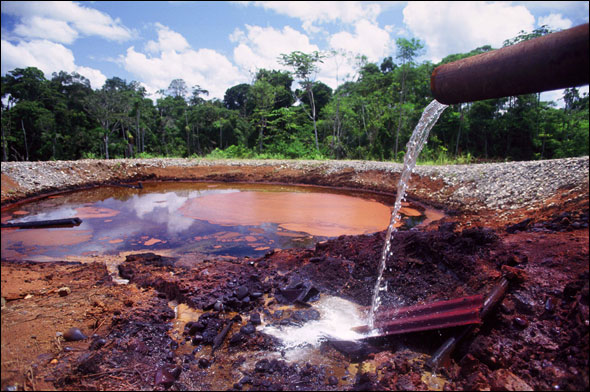
Chevron claims that these sites are not health hazards, but in the U.S. it wouldn’t even be a question,” Lou Dematteis, photographer of Crude Reflections: Oil, Ruin and Resistance in the Amazon Rainforest, told Circle of Blue. “There is standing oil, oil a foot under the ground—that would automatically become a Superfund site. The people living there wouldn’t have to go to court to prove that. You don’t have to do that in the States anymore, but you used to.”
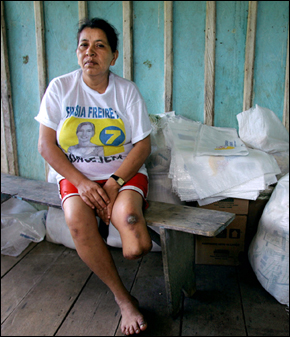
The indigenous community asserts that 50 years of negligent drilling practices and the creation of hundreds of open-air, unlined pits have let toxic oilfield waste and crude oil seep into the ground and streams. The river water is used by the people for laundry, bathing, cooking and drinking and has caused higher rates of cancer than are found in the rest of the country, assert plaintiffs, who are seeking $US27 billion in damages. Records obtained by the plaintiffs indicate that 19 billion gallons of toxic wastewater and 17 million gallons of raw crude oil have been discharged into the rainforest, wrecking an indigenous way of life and an ecosystem.
Chevron insists that these inflated illness rates are caused by poor sanitation in the region. The oil giant, which inherited the lawsuit when it bought Texaco in 2001, says that Texaco cleaned up its share of the mess, and that the remainder is the responsibility of PetroEcuador, the local corporation.
“Back in 1993, there were mostly just digestive problems and skin rashes,” Dematteis said. “But a doctor with the Ecuadorian Ministry of Public Health told me there was so much pollution that there was going to be a plague of all different types of cancer. When I went back in 2003, that was exactly what had happened—in those ten years, there were so many people who had already died.”
Cutting Crude Corners in Northern Russia Causes Flood of Petroleum Pollution
A legacy of oil spills and dilapidated infrastructure linger in the far north Komi region of Russia, an oil development zone once known for its abundant fisheries and pristine waterways. After a series of major oil spills in 1994 totaling 730,000 barrels (30.6 million gallons), the fragile tundra is now a barren wasteland.
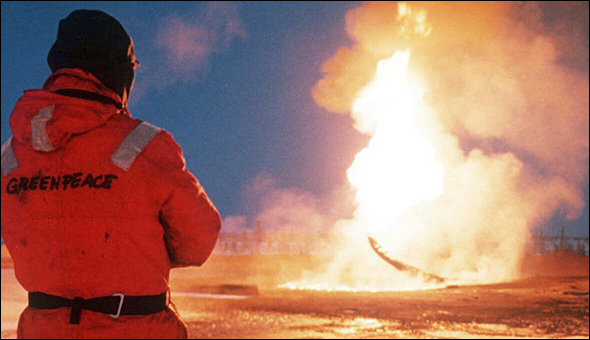
Rather than replacing 70 kilometers of antiquated infrastructure that had been leaking for months, Komineft, the local business opted to patch the holes. And while the company was fined $US600,000, it couldn’t pay for the majority of the cleanup because it was on the brink of bankruptcy.
Since there were not sufficient funds to cleanup the damage, more than 350 lakes in the Arctic region remain polluted with petroleum from leaking pipelines that have served the region since the first Soviet oil rig was built in 1974, according to a 2006 report by the International Science and Technology Center, an organization of former Soviet Union republics and Russia that facilitates external scientific exchanges.
The international community paid scant attention to the region’s ongoing spills until heavy rainfall in October of 1994 knocked out an earthen dam that had contained 20 percent of the region’s motherlode of contaminated water and crude. Oil raced through tributaries of the salmon-rich Pechora River, which drains into the Arctic Ocean. Komineft was accused of cutting corners and not making timely repairs.
Before the spill, communities downstream of the Komineft installation used the region’s rivers for domestic and commercial needs. One month after the October catastrophe, however, dangerous levels of contaminants were found in water samples, according to a World Bank report.
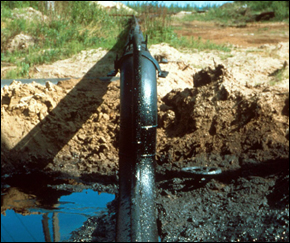
Sixteen years after the Komineft petroleum spills devastated the Siberian landscape, archaic infrastructure remains a liability for Russia’s oil industry. In West Siberia, poorly constructed and maintained pipelines cause an estimated 35,000 to 40,000 accidents each year, with much of the spilled oil pouring into waterways, according to a report by IWACO BV Consultants for Water and Environment that was that was commissioned by Greenpeace.
“They are willing to spend money to build new pipelines but are reluctant to modernize the existing system,” said Robert Ebel, senior adviser of the Energy and National Security Program at the Center for Strategic and International Studies, in an interview with Circle of Blue. “It can break anytime. I don’t know when, but it is inevitable.”
Scraping the Life From Alberta’s Tar Sands
Sometime later this year, according to Cambridge Energy Associates, a research group, the tar sands of Alberta, Canada will become the single largest source of imported oil to the United States. In order to reach the bitumen-saturated sands, huge strip mining equipment scrapes the boreal forest and the underlying soil and sediment away. Processing every barrel of oil demands four barrels of freshwater.
Toxic wastewater is stored in immense tailings ponds and lagoons so poisonous that waterfowl perish if they land on the surface, according to government reports. The lagoons, held back by earthen berms, are leaking into wetlands and the Athabasca River, which flows through northern Alberta, where the tar sands cover an area as large as North Carolina.
Tar sands development, which has produced a huge scar on the land that is easily visible from space, is the most environmentally damaging and polluting industrial enterprise of the 21st century, according to a number of studies by scientists and environmental advocates. Moreover, the feverish work to turn saturated sand into oil is just in its initial stages, with no end in sight.
Financial disclosure forms and other economic reports show that Exxon, Shell, BP and other oil companies are spending $US12 billion per year to accelerate the pace of production, which has quickly reached 1.3 million barrels per day and is climbing. The tar sands contain 1.7 trillion barrels of oil, according to the Canadian government, and a reserve of recoverable oil conservatively estimated at 173 billion barrels–second only to Saudi Arabia.
The governments of Canada and the U.S. are quietly negotiating agreements that will enable the oil industry to build pipelines from northern Alberta to America, where new refineries are proposed for Michigan, Maine and South Dakota.
View Catastrophic Oil Spills in a larger interactive map. Click on a number to read specific statistics about each of the Top 10 Global Oil Spills. Click on a blue circle to read specific statistics about each oil spill highlighted in this Circle of Blue special report.
Aubrey Ann Parker is a reporter for Circle of Blue where she specializes in data visualization. Jordan Bates created the data visualization map.
Brett Walton, Molly Walton and Keith Schneider contributed reporting. Reach them at

is a Traverse City-based assistant editor for Circle of Blue. She specializes in data visualization.
Interests: Latin America, Social Media, Science, Health, Indigenous Peoples

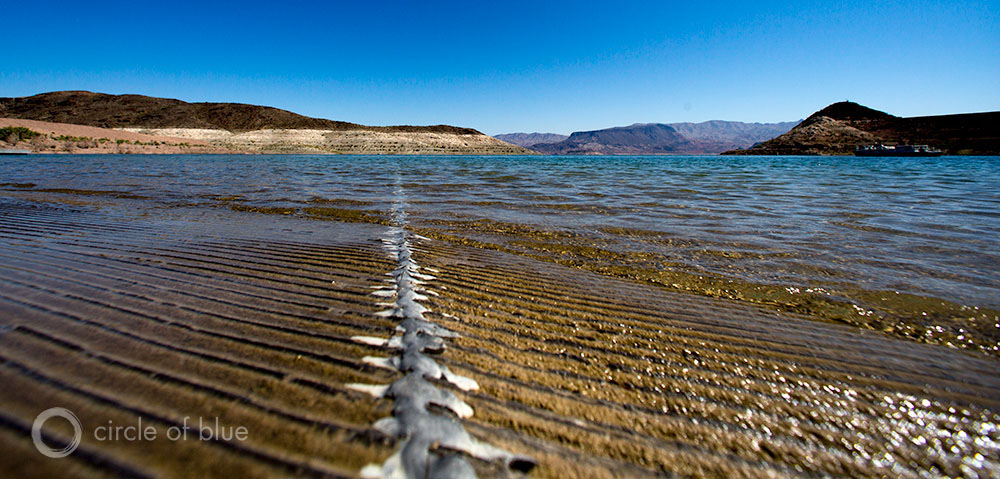
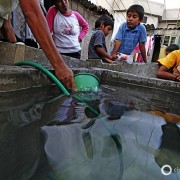




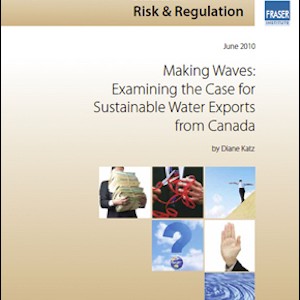
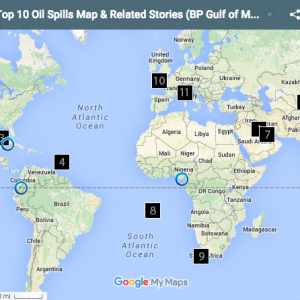
Leave a Reply
Want to join the discussion?Feel free to contribute!